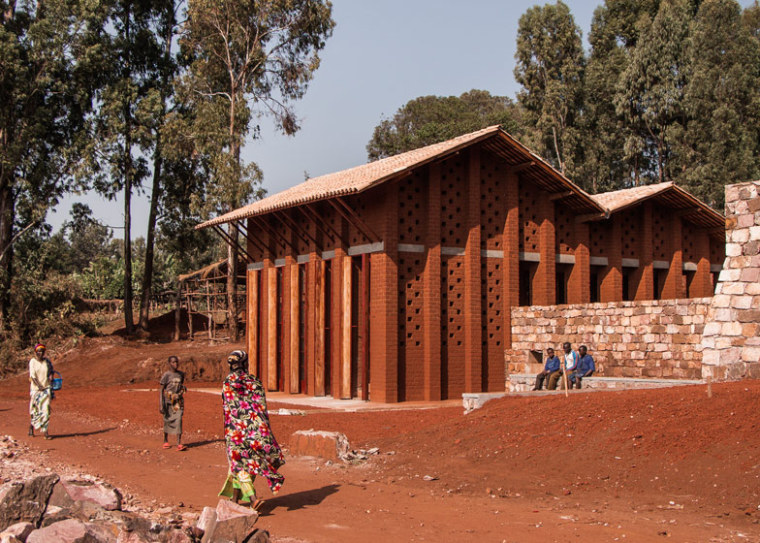African children's library with rammed earth walls by BC Architects
设计方:建筑事务所 :BC Architects
分类:文化建筑
内容:实景照片
合作人:ODEDIM Muyinga NGO, Satimo vzw, Sint-Lucas Architecture University, Sarolta Hüttl, Sebastiaan De Bei
成本:€40 000
委托人:ODEDIM
建筑年份:2012
项目规模:140平方米
图片:20张
摄影师:BC Architects

这是由BC Architects设计的穆因加社区图书馆。项目位于非洲布隆迪,建筑用夯土墙砌成,是来自比利时的建筑工作室BC Architects与当地社区成员共同合作建成的。该项目旨在为失聪儿童建立一所新学校,建筑参照当地建筑样式,采用当地材料和施工技术,是穆因加第一间图书馆。
设计团队首先研制“开放结构”的模板,然后将其应用到建筑上,同时考虑到生命循环系统、水循环系统以及能源循环系统。该项目正是建立于充足的研究与理论之上。
然后通过两个月的实地考察,设计团队了解了当地及周边省份的材料、建造技术以及建筑类型。这些考察成果有助将穆因加当地文化与传统融入到建筑设计中。
图书馆采用一条有遮盖的外廊组织主要交通流线,这个外廊的设计正是源自布隆迪传统房屋形式,它可遮阳挡雨,同时居民可在这里相遇、休息、教堂、等待——是一个真正的社会空间,构成社区关系。在图书馆设计中,故意放大外廊的比例,形成图书馆的户外空间。透明的门使得室内外形成相互作用。当门完全打开时,可欣赏壮丽的布隆迪山景。
布隆迪十分注重建筑边界的划分。这是一个传统,可以追溯到古代部落的做法。对于穆因加图书馆,采用了组合墙来划定边界。组合枪采用干土法制成,可作为斜坡平台上的挡土墙,比如学校周边较低的广场、操场,或者较高的街道边。如此挡土城既安全而又不遮挡风景。
建筑建材方面采用了加压土砖与瓦片。建筑内外呈现一种重复性的韵律。屋顶坡度为35%,有利于保护未焙烧的加压土砖,形成优美的建筑形态。
建筑体量与外观同样考虑到气候因素,室内较大的层高有助连续交叉通风,排出湿热的空气。而建筑外墙的压缩土砖留有孔隙,夜间的图书馆就成为一个小发光体。沿街面双层高的房间为读者提供特别的空间,包括建筑首层的木椅区、夹层的麻绳吊椅区。
设计团队要面对当地建材和劳动力资源有限的现实,采用了夯土、压缩土砖、桉木、瓷砖、粘土、竹、麻绳、混凝土等材料。
译者: 艾比
This children's library with rammed earth walls in Burundi, Africa, was built by Belgian studio BC Architects and members of the local community, according to an open-source design template (+ slideshow).
The Library of Muyinga
Architecture
The first library of Muyinga, part of a future inclusive school for deaf children, in locally sourced compressed earth blocks, built with a participatory approach.
Our work in Africa started within the framework of OpenStructures.net. BC was asked to scale the "Open structures" model to an architectural level. A construction process involving end-users and second-hand economies was conceived. Product life cycles, water resource cycles en energy cycles were connected to this construction process. This OpenStructures architectural model was called Case Study (CS) 1: Katanga, Congo. It was theoretical, and fully research-based. 5 years later, the library of Muyinga in Burundi nears completion.
Vernacular inspirations
A thorough study of vernacular architectural practices in Burundi was the basis of the design of the building. Two months of fieldwork in the region and surrounding provinces gave us insight in the local materials, techniques and building typologies. These findings were applied, updated, reinterpreted and framed within the local know-how and traditions of Muyinga.
The library is organised along a longitudinal covered circulation space. This "hallway porch" is a space often encountered within the Burundian traditional housing as it provides a shelter from heavy rains and harsh sun. Life happens mostly in this hallway porch; encounters, resting, conversation, waiting - it is a truly social space, constitutive for community relations.
This hallway porch is deliberately oversized to become the extent of the library. Transparent doors between the columns create the interaction between inside space and porch. Fully opened, these doors make the library open up towards the adjacent square with breathtaking views over Burundi's "milles collines" (1000 hills).
On the longitudinal end, the hallway porch flows onto the street, where blinders control access. These blinders are an important architectural element of the street facade, showing clearly when the library is open or closed. On the other end, the hallway porch will continue as the main circulation and access space for the future school.
A very important element in Burundian (and, generally, African) architecture is the very present demarcation of property lines. It is a tradition that goes back to tribal practices of compounding family settlements. For the library of Muyinga, the compound wall was considered in a co-design process with the community and the local NGO. The wall facilitates the terracing of the slope as a retaining wall in dry stone technique, low on the squares and playground of the school side, high on the street side. Thus, the view towards the valley is uncompromised, while safety from the street side is guaranteed.
The general form of the library is the result of a structural logic, derived on one hand from the material choice (compressed earth blocks masonry and baked clay roof tiles). The locally produced roof tiles were considerably more heavy than imported corrugated iron sheets. This inspired the structural system of closely spaced columns at 1m30 intervals, which also act as buttresses for the high walls of the library. This rhythmic repetition of columns is a recognisable feature of the building, on the outside as well as on the inside.
The roof has a slope of 35% with an overhang to protect the unbaked CEB blocks, and contributes to the architecture of the library.
Climatic considerations inspired the volume and facade: a high interior with continuous cross-ventilation helps to guide the humid and hot air away. Hence, the facade is perforated according to the rhythm of the compressed earth blocks (CEB) masonry, giving the library its luminous sight in the evening.
The double room height at the street side gave the possibility to create a special space for the smallest of the library readers. This children's space consist of a wooden sitting corner on the ground floor, which might facilitate cosy class readings. It is topped by an enormous hammock of sisal rope as a mezzanine, in which the children can dream away with the books that they are reading.
The future school will continue to swing intelligently through the landscape of the site, creating playgrounds and courtyards to accomodate existing slopes and trees. In the meanwhile, the library will work as an autonomous building with a finished design.
Local materials research
The challenge of limited resources for this project became an opportunity. We managed to respect a short supply-chain of building materials and labour force, supporting local economy, and installing pride in the construction of a library with the poor people's material: earth.
Earth analysis: "field tests and laboratory tests" - Raw earth as building material is more fragile than other conventional building materials. Some analyse is thus important to do. Some easy tests can be made on field to have a first idea of its quality. Some other tests have to be made in the laboratory to have a beter understanding of the material and improve its performance.
CEB: "from mother nature" - After an extensive material research in relation with the context, it was decided to use compressed earth bricks (CEB) as the main material for the construction of the building. We were lucky enough to find 2 CEB machines intactly under 15 years of dust. The Terstaram machines produce earth blocks of 29x14x9cm that are very similar to the bricks we know in the North, apart from the fact that they are not baked. Four people are constantly producing stones, up to 1100 stones/day.
Eucalyptus "wood; the strongest, the reddest" - The load bearing beams that are supporting the roof are made of eucalyptus wood, which is sustainably harvested in Muramba. Eucalyptus wood renders soil acid and therefor blocks other vegetation to grow. Thus, a clear forest management vision is needed to control the use of it in the Burundian hills. When rightly managed, Eucalyptus is the best solution to span spaces and use as construction wood, due to its high strengths and fast growing.
Tiles: "local quality product" - The roof and floor tiles are made in a local atelier in the surroundings of Muyinga. The tiles are made of baked Nyamaso valley clay. After baking, their color renders beautifully vague pink, in the same range of colors as the bricks. Each roof surface in the library design consists of around 1400 tiles. This roof replaces imported currogated iron sheets, and revalues local materials as a key design element for public roof infrastructure.
Internal Earth plaster: "simple but sensitive" - Clay from the valley of Nyamaso, 3 km from the construction site, was used for its pure and non-expansive qualities. After some minimal testing with bricks, a mix was chosen and applied on the interior of the library. The earth plaster is resistent to indoor normal use for a public function, and has turned out nicely.
Bamboo: "Weaving lamp fixtures" - Local bamboo is not of construction quality, but can nicely be used for special interior design functions, or light filters. In a joint workshop with Burundians and Belgians, some weaving techniques were explored, and in the end, used for the lamp fixtures inside the library.
Sisal rope: "from plant to hammock" - Net-making from Sisal plant fibres is one of the small micro-economies that bloomed in this project. It took a lot of effort to find the only elder around Muyinga that masters the Sisal rope weaving technique. He harvested the local sisal plant on site, and started weaving. In the pilote project, he educated 4 other workers, who now also master this technique, and use it as a skill to gain their livelihood. The resulting hammock serves as a children’s space to play, relax and read, on a mezzanine level above the library space.
Concrete "when it’s the only way out" - For this pilot project, we didn't want to take any risks for structural issues. A lightweight concrete skeleton structure is inside the CEB columns, in a way that both materials (CEB and concrete) are mechanichally seperated. The CEB hollow columns were used as a "lost" formwork for the concrete works. It is our aim, given our experience with Phase 1, to eliminiate the structural use of concrete for future buildings.

非洲穆因加社区图书馆外观图

非洲穆因加社区图书馆外观图

非洲穆因加社区图书馆背面外观图

非洲穆因加社区图书馆内部局部图

非洲穆因加社区图书馆

非洲穆因加社区图书馆

非洲穆因加社区图书馆

非洲穆因加社区图书馆

非洲穆因加社区图书馆

非洲穆因加社区图书馆

非洲穆因加社区图书馆

非洲穆因加社区图书馆

非洲穆因加社区图书馆

非洲穆因加社区图书馆

非洲穆因加社区图书馆

非洲穆因加社区图书馆

非洲穆因加社区图书馆

非洲穆因加社区图书馆平面图

非洲穆因加社区图书馆剖面图

非洲穆因加社区图书馆外观图

非洲穆因加社区图书馆外观图

非洲穆因加社区图书馆背面外观图

非洲穆因加社区图书馆内部局部图

非洲穆因加社区图书馆

非洲穆因加社区图书馆

非洲穆因加社区图书馆

非洲穆因加社区图书馆

非洲穆因加社区图书馆

非洲穆因加社区图书馆

非洲穆因加社区图书馆

非洲穆因加社区图书馆

非洲穆因加社区图书馆

非洲穆因加社区图书馆

非洲穆因加社区图书馆

非洲穆因加社区图书馆

非洲穆因加社区图书馆

非洲穆因加社区图书馆平面图

非洲穆因加社区图书馆剖面图
北京 | 建筑设计
15 关注
999+ 粉丝
999+ 发帖
109 荣誉分
∨

简介
二维码(建议尺寸80*80)






